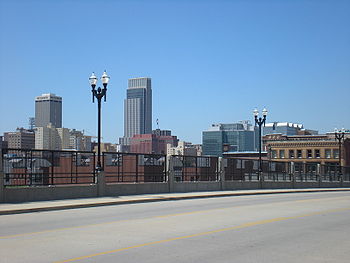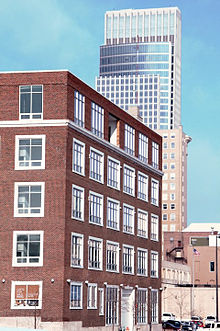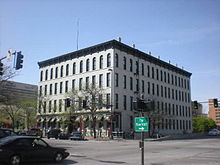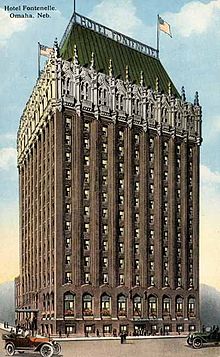- Downtown Omaha
-
 View of Downtown Omaha looking west from the Gene Leahy Mall
View of Downtown Omaha looking west from the Gene Leahy Mall
Downtown Omaha is the central business, government and social core of the Omaha-Council Bluffs metropolitan area, and is located in Omaha, Nebraska. The boundaries are 20th Street on the west to the Missouri River on the east and the centerline of Leavenworth Street on the south to the centerline of Chicago Street on the north, also including the CenturyLink Center Omaha.[1] Downtown sits on the Missouri River, with commanding views from the tallest skyscrapers.
Dating almost to the city's inception, downtown has been a popular location for the headquarters of a variety of companies. The Union Pacific Railroad has been headquartered in Omaha since its establishment in 1862. Once the location of 24 historical warehouses, Jobbers Canyon Historic District was the site of many import and export businesses necessary for the settlement and development of the American West. Today dozens of companies have their national and regional headquarters in downtown Omaha.[2]
The area is home to more than 30 buildings listed on the National Register of Historic Places, along with two historic districts. Downtown Omaha was also the site of the Jobbers Canyon Historic District, all 24 buildings of which were demolished in 1989, representing the largest single loss of buildings to date from the National Register.[3]
Contents
History
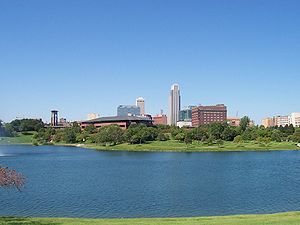 Skyline from Heartland of America Park
Skyline from Heartland of America Park
Downtown Omaha was the location of the settlement of the city. William D. Brown's Lone Tree Ferry landing was the site of Omaha's first development. In 2004 a map expert using GPS and old maps identified a location near Gallup University as the location of the ferry landing.[4] Omaha Central High School, located at 124 North 20th Street, is on the site where the city's founders first met on July 4, 1854 for a celebration to found the city.
Much of Omaha's grim history happened downtown, as well. The Douglas County Courthouse was twice the location of racially motivated lynchings. The first occurred when George Smith, a local worker, was accused of raping a white woman and dragged from the jail in the courthouse to his death.[5] The second was the mass mob murder of Willy Brown in 1919, in which Mayor Ed Smith was lynched and almost murdered as well. The event, coordinated by city boss Tom Dennison, was in retaliation of Smith's reform administration. Dennison operated a private bank at 1409 Douglas Street, bankrolling a number of illegal operations throughout the city.[6] He was likely in control of the city's Sporting District, a downtown neighborhood where debauchery of all sorts took place.
Today the highlight of downtown's social scene, the Old Market was once a warehouse district on par with the Jobbers Canyon. Torn down in 1989, Jobbers Canyon was a large area of warehouses in which much of Omaha's industrial wealth was made. Other historical areas downtown included Chinatown, the Burnt District and the Sporting District. The latter two areas were locations for much of the crime in Omaha in the late 19th century and early 20th century.
Neighborhoods
Downtown Omaha is generally thought of as a large neighborhood itself; however, currently and historically within it are several distinct areas. The Old Market Historic District has been rehabilitated into boutique shops, offices and loft residential units. On the south edge of downtown bordering Little Italy, the Burlington Station is one of the buildings in the Omaha Rail and Commerce Historic District that has been renovated into residential apartments.
North Downtown
"NoDo" redirects here. For other uses, see Nodo.A new mixed-use development, North Downtown extends 80 blocks, from the campus of Creighton University to the Qwest Center and new developments along the Missouri River. The boundaries are Seward Street on the north, I-480 on the south, 17th Street to the west and Riverfront Drive on the east.[7]
The area comprising NoDo is central to the history of Omaha. Along the river, Miller's Landing was the site where the Lone Tree Ferry brought settlers from Iowa. The early Territorial Legislature platted Scriptown in the area. The historic neighborhood of Squatter's Row and the city's notorious prostitution alleyway, The Cribs, were located here.
Today the area includes the new Slowdown venue.[8] The new TD Ameritrade Park opened in April 2011 near the Qwest Center as the new home of the College World Series and Creighton University baseball. The area also includes national retail such as Urban Outfitters and American Apparel and several restaurants, bars, and coffee shops. The Hot Shops Art Center is located here where local artists have work on display. Three new hotels have recently[when?] opened; Holiday Inn, Homewood Suites, and a Hampton Inn & Suites; these are in addition to the Hilton Omaha already located across from the Qwest Center. Several buildings have also been renovated into apartments and condos. The Missouri River riverfront is the eastern boundary of NoDo where millions in redevelopment has taken place in recent years. The city has created a new boardwalk, walking trails, and the Lewis & Clark Landing which connect to the Heartland of America Park and, in-conjunction, host several of Omaha's annual festivals, like the Taste of Omaha. A city marina has opened for Missouri River boaters and Rick's Boatyard is an nautical theme restaurant that opened on the boardwalk in November 2002. Buildings along the riverfront include The National Park Service, Mid-West Regional Headquarters and Lewis and Clark National Historic Trail visitors center, The Gallup Organization operational headquarters, Gallup University Campus, and two residential towers, RiverFront Place Condos. Near these buildings is the 3,000 ft footbridge, the Bob Kerrey Pedestrian Bridge.
The movement in Omaha to reintroduce street cars is led by former mayor Hal Daub.[9] The proposed streetcars would cost $55 million and run in a 3.5-mile (5.6 km) loop through Downtown Omaha and NoDo. The system would cost about $2 million per year to operate and would serve almost 7,000 passengers in its first year. One route would run the cars from Creighton University near 20th and Webster streets, proceeding east to 10th Street, passing by the Qwest Center and moving south to Jackson Street in the Old Market. After that it would then move west to 16th Street and then north to Farnam before returning to 10th Street.[10]
 View of North Downtown looking to the East; TD Ameritrade Park Omaha rises behind the Slowdown venue.
View of North Downtown looking to the East; TD Ameritrade Park Omaha rises behind the Slowdown venue.
North Downtown establishments Name Location Qwest Center 455 North 10th Street TD Ameritrade Park Creighton University 320 N 20th St Slowdown 729 North 14th Street Morrison Stadium 2500 California Plaza Miller's Landing 151 Freedom Park Rd Lewis and Clark National Historic Trail Headquarters 601 Riverfront Drive RiverFront Place Condos 555 Riverfront Plz Gallup University Campus 1001 Gallup Dr Park East
This neighborhood is considered the gateway to Downtown Omaha. Although, due to its tall buildings and proximity to downtown, most Omaha citizens consider this area to be part of the downtown central district. The area runs from 20th street on the east to 28th street on the west and from Dodge street to the north and Leavenworth to the south. The neighborhood, situated between Midtown Omaha and Downtown, is home to several historic buildings as well as some of Omaha's tallest buildings. The area has some of Omaha's major art institutions such as the Joslyn Art Museum, the Omaha Children's Museum, and the The Rose Theater. There are still major employers in the area, such as Physicians Mutual Insurance Co, but there is also evidence of better days gone past such as the now vacant Northern Natural Gas Building. Omaha's Destination Midtown has been working to restore the area in recent years, as well as other Midtown neighborhoods, and evidence of revitalization can be seen in newly restored condos and apartments in the area. As of 2004, an elementary school, Liberty Elementary, has been established to serve the growing downtown population.[11]
 Dodge Street heading west, entering Park East. The Northern Natural Gas Building in view is the tallest building in the Park East neighborhood.
Dodge Street heading west, entering Park East. The Northern Natural Gas Building in view is the tallest building in the Park East neighborhood.
Home to the original Nebraska State Capitol, the Park East neighborhood has hosted several significant historical buildings and structures. One of Omaha's original parks, Jefferson Square, was located in the neighborhood, with the Market House and Omaha's first school located in the park. The Old Post Office and other buildings were there, too.
Park East establishments Name Location Joslyn Art Museum 2200 Dodge St Omaha Children's Museum 500 S 20th St The Rose, Omaha 2665 Farnam St Northern Natural Gas Building 2223 Dodge Street Physicians Mutual Building 2600 Dodge St Westbrook Tower 2121 Douglas St Omaha Central High School 124 N. 20th St Scoular Building 2027 Dodge St. Ford Hospital 121 South 25th Street Old Market
Main article: Old Market (Omaha, Nebraska)The Old Market is a neighborhood bordered by South 10th Street. The neighborhood has many restaurants, art galleries and upscale shopping, and is the location of several condominiums, including the JLofts on the Market and the Broatch Building. The area retains its brick paved streets from the turn of the 20th century, horse-drawn carriages, and covered sidewalks in some areas. It is not uncommon to see a variety of street performers, artists and other vendors.
Notable locations Name Location Poppleton Block 1001 Farnam Street St. Nicholas Hotel 12th and Jackson Streets Anheuser-Busch Beer Depot 1207-1215 Jones Street Douglas House 13th and Harney Streets Omaha Bolt, Nut and Screw Building 1316 Jones Street First Woodman of the World Building 15th and Howard Streets Grand Central Hotel 14th and Farnam Streets Market West
Market West is a newly established neighborhood to the west of the Old Market and to the south of the Central Business District. Market West is represented by the Market West Neighborhood Alliance, established in 2011. The official boundaries are construed as, but not limited to, S 17th street to the west, S 13th street to the east, Howard street to the north and the train tracks to the south.
Part of Market West is included in the Omaha Rail and Commerce Historic District. While the neighborhood is dominated by historic warehouses, the area is beginning to see new construction of apartment buildings. The area of Market West is often confused with the Old Market, as south 13th street is the most obvious boundary - the actual historically designated area of the Old Market Historic District is a few square blocks.
Notable Historic Buildings Name Location Aquila Court Building (Magnolia Hotel) 1615 Howard Street Douglas Eggerss-O'Flyng Building 801 South 15th Street Flatiron Hotel 1722 St. Mary's Avenue Hill Hotel 505 South 16th Street Omaha Bolt, Nut and Screw Building 1316 Jones Street Restoration and expansion projects
 The Brandeis Building, in downtown, has recently[when?] gone through a major restoration project.
The Brandeis Building, in downtown, has recently[when?] gone through a major restoration project.
Several projects commencing in Downtown Omaha are restoring and expanding the city's core. One is the 32 story 373-foot (114 m) condominium tower called WallStreet Tower Omaha, which will be the third tallest building in Omaha, passing the Masonic Manor. The project was designed by Townsend Inc. of Overland Park, Kansas, which has also purchased the Brandeis Building in downtown and finished converting the old department store into a high-end mixed use development. The WallStreet project is estimated to be completed by 2011. Omaha's own HDR, Inc. designed downtown's important Omaha World-Herald Freedom Center, which opened in 2001.
The Bob Kerrey Pedestrian Bridge is sparking a riverfront expansion project in Omaha and Council Bluffs. The bridge has a very modern design with two 200-foot (61 m) spires that have sail-like appearances and mulit-color LED light panels at the top. The Omaha side of the riverfront project has restaurants, businesses, and two condo towers twelve and fifteen stories tall and a large plaza area with jumping fountains, statues, and seating.
A new downtown baseball stadium, TD Ameritrade Park, is under construction in the NoDo area. The stadium will seat 24,000 and could be expanded to hold as many as 35,500. The stadium will feature open air concourses and will have impressive views of the downtown skyline from the third base side. The stadium will face southeast towards the Qwest Center, and the new riverfront developments, the Bob Kerrey Pedestrian Bridge and, RiverFront Place Condos.
Headquarters
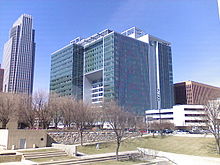 Union Pacific Center, the UP headquarters building
Union Pacific Center, the UP headquarters building
Downtown Omaha is home to several corporate headquarters for businesses of international, national and regional importance. Among the earliest were the U.S. Army's Department of the Platte[12] and the Union Pacific Railroad. Union Pacific laid its first rails in Omaha in 1862, and its headquarters have been located in Downtown Omaha since then. The company has stated their commitment to maintain their headquarters in Omaha, particularly with the opening of the new Union Pacific Center in 2004.[13] The Enron corporation began in downtown as Northern Natural Gas Company, until they relocated their headquarters to Houston, TX.[14] ConAgra Foods relocated their headquarters from Central Park Plaza in central downtown, to a riverfront campus in 1990, after a contentious battle with local historians of the destruction of the Jobbers Canyon Historic District to make room for their buildings. In 2002, First National Bank of Omaha moved into the 42-story First National Bank Tower as headquarters for the company.
The Gallup Organization built an $81 million operational headquarters that employs 650 people on the edge of downtown in 2001.[15] RDG Planning & Design followed in 2004, winning awards for moving and contributing to downtown's growth.[16] The Scoular Company, a grain trading & storing company, is headquartered in downtown Omaha in the Scoular Building.[17] The new Carl T. Curtis National Park Service Midwest Headquarters located downtown on the Missouri Riverfront is the first building in Nebraska to be rated under the Leadership in Energy and Environmental Design system.[18]
Neighboring Creighton University has been steadily expanding their campus in order to "integrate with Downtown Omaha". New facilities such as Morrison Stadium bring the university closer.[19] Other locally relevant organizations downtown include all of the city's utilities. The Metropolitan Utilities District, Omaha Public Power District, Omaha Police Department, the Omaha Housing Authority and Metro Area Transit are each located within downtown. The U.S. Army Corps of Engineers Omaha District is headquartered in Downtown Omaha, as well.[20]
Pacific Life's Omaha operations is headquartered in the 1200 Landmark Center and the Omaha World Herald has its headquarters, as well as its state of the art printing press, the Freedom Center, downtown.
Attractions
Basketball game at the CenturyLink Center Omaha in downtown Main article: Tourism in Omaha
Main article: Tourism in OmahaAside from the Old Market, other attractions in Downtown Omaha include the historic Orpheum Theater, which was built by influential Omaha philanthropist John A. Creighton, whose family also built the city's Creighton University. Along with the Rose Blumkin Performing Arts Center, this is the oldest theater left in downtown. Other performance spaces downtown include the Magic Theatre, which features experimental theater.
The Omaha Children's Museum, Durham Western Heritage Museum, and the Holland Performing Arts Center are all important visual arts spaces downtown, while the CenturyLink Center Omaha and the Omaha Civic Auditorium play host to many different events, including concerts, sports and more. Slowdown is a new cultural center that straddles the boundaries of NoDo and the Near North Side neighborhood.
Heartland of America Park and the Gene Leahy Mall play host to outdoor concerts and other events throughout the year.
Architecture
Downtown Omaha was the original site of the city of Omaha, where the riverfront held businesses and the area surrounding it bore the brunt of its commercial, residential, and social activities. The Omaha National Bank Building was the first tower in downtown. Constructed in 1888-89, the building was designed in the Renaissance Revival style by the New York architectural firm of McKim, Mead, and White. The firm designed an identical office tower for the New York Life Insurance Company in Kansas City, Missouri. The building was Omaha's first ten-story structure.[21] There has been a recent revitalization of the area, with several notable new buildings and other developments taking place. Following are some of the notable locations throughout the area.
Tallest buildings
See also: List of tallest buildings in Omaha, NebraskaOmaha's tallest building, the 45-story First National Bank Tower, is in Downtown. There is a proposed 373-foot (114 m), 32-story downtown condominium tower in the works. The WallStreet Tower Omaha would be built as soon as fall 2011 in Downtown.[22]
 View from city hall plaza; buildings in view are Woodmen Tower, One First National Center, and the Omaha National Bank Building.
View from city hall plaza; buildings in view are Woodmen Tower, One First National Center, and the Omaha National Bank Building.
Tallest buildings in Downtown Omaha Name Location Stories Height One First National Center 1601 Dodge Street 45 634 ft (193 m) Woodmen Tower 1805 Douglas Street 30 478 ft (146 m) Union Pacific Center 1400 Douglas Street 19 317 ft (97 m) First National Center 1620 Dodge Street 22 295 ft (90 m) AT&T Building 116-124 South 19th Street 16 265 ft (81 m) Northern Natural Gas Building 2233 Dodge Street 19 260 ft (79 m) 1200 Landmark Center 1299 Farnam Street 15 255 ft (78 m) Omaha World Herald Building 1314 Douglas Street 16 250 ft (76 m) Double Tree Hotel 1616 Dodge Street 19 237 ft (72 m) City National Bank Building (Omaha) 411 South 16th Street 16 220 ft (67 m) Historic districts
The Old Market Historic District is bordered by Farnam Street on the north to Leavenworth on the south, from South 10th Street on the east to South 14th Street on the west. The Omaha Rail and Commerce Historic District is bounded by Jackson, 15th and 8th Streets, as well as the Union Pacific main line. Both are also listed as historic districts on the National Register of Historic Places. Downtown Omaha is also the site of the largest single loss of buildings included on the National Register of Historic Places to date.[3] All of the 24 buildings in the Jobbers Canyon were demolished in 1989, to be replaced by the ConAgra headquarters and Heartland of America Park.[23] The Warehouses in Omaha Multiple Property Submission brings together several historic locations around Downtown Omaha, as well.
Historic buildings
According to a 1939 publication by the Federal Writers Project, the downtown core has at least 23 historic sites that were central to the growth and development of the city.[24] Many significant buildings have been recognized as landmarks, including the following, which are all included on the National Register of Historic Places.[25][26]
 Anheuser-Busch Beer Depot in the Old Market Historic District with the Bemis Omaha Bag Company Building in the background.
Anheuser-Busch Beer Depot in the Old Market Historic District with the Bemis Omaha Bag Company Building in the background.
 The Astro Theater, now known as The Rose Theater is located in the Park East neighborhood of downtown.
The Astro Theater, now known as The Rose Theater is located in the Park East neighborhood of downtown.
 The Burlington Station, a contributing property to the Omaha Rail and Commerce Historic District in downtown Omaha.
The Burlington Station, a contributing property to the Omaha Rail and Commerce Historic District in downtown Omaha.
Historic buildings in Downtown Omaha Place name Location Notes Anheuser-Busch Beer Depot 1215 Jones Street Built in 1916. Ansonia Apartments Aquila Court Building 1615 Howard Street Built in 1923. Astro Theater 2001 Farnam Street Built in 1926. Beebe and Runyan Furniture Showroom and Warehouse 105 South 9th Street Built in 1913. Bemis Omaha Bag Company Building 614-624 South 11th Street Built in 1887. Broatch Building Burlington Headquarters Building 1004 Farnam Street Built in 1879. Burlington Station 925 South 10th Street Built in 1898. City National Bank Building (Omaha) 405 S 16th St Built in 1910. Douglas County Courthouse 1819 Farnam Street Built in 1908, this site was labeled a key historic site by the Federal Writers Project.[27] Douglas Eggerss-O'Flyng Building 801 South 15th Street Built in 1902. Farnam Building 1613 Farnam Street Built in 1929. Federal Office Building 110 South 15th Street Built in 1934. First National Bank Building 300-312 South 16th Street 1917. Flatiron Hotel 1722 St. Mary's Avenue Built in 1914. Florentine Apartments G.C. Moses Block 1234-1244 South 13th Street Built in 1887. Goodrich Building Hill Hotel 505 South 16th Street Built in 1919. Horbach Building Hospe Anton Music Warehouse 109-111 South 10th Street Built in 1919. J.L. Brandeis and Sons Store Building 200 South 16 Street Built in 1906. Keeline Building 319 South 17th Street Built in 1911. Kennedy Building Kimball House Mason School Nash Block 902-912 Farnam Street Built in 1905. Omaha Bolt, Nut and Screw Building 1316 Jones Street Built in 1889. Omaha High School 124 North 20th Street Built in 1912, the Capitol Hill site was labeled a key historic site by the Federal Writers Project.[27] Old Omaha Public Library building 1823 Harney Street The original location of the Omaha Public Library was built in 1891. Omaha National Bank Building 1650 Farnam Street Built in 1889, this site was labeled a key historic site by the Federal Writers Project.[27] Orpheum Theater 409 South 16th Street Built between 1892 and 1927 Parlin, Orendorff and Martin Plow Company Building Paxton Hotel 1403 Farnam Street Original building constructed 1882 was demolished and rebuilt to current building in 1928 Poppleton Block 1001 Farnam Street Built in 1890. Redick Tower 1504 Harney Street Built in 1930. Rose Realty-Securities Building 305 South 16th Street Built in 1916. Sanford Hotel 1913 Farnam Street Constructed in 1913. Simon Brothers Company 1024 Dodge Street This building was constructed in 1919. Christian Specht Building 1110 Douglas Street Built in 1884, this building barely survived destruction in 2007. Standard Oil Company Building of Nebraska 500 South 18th Street Steiner Rowhouses Trinity Cathedral (Omaha, Nebraska) 113 North 18th St Built in 1880 Union State Bank Building Union Station 801 South 10th Street Built in 1931, it currently houses the Durham Museum. Former locations
The location of the William D. Brown's Lone Tree Ferry, downtown has been the pivotal site for Omaha's growth since the city's inception in 1854. The following are all buildings, districts and other notable locations in Omaha that have been lost over the last 150 years.[28][29]
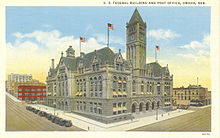 The 1898 Omaha Post Office.
The 1898 Omaha Post Office.
Former locations in Downtown Omaha Name Location Notes Bee Building 17th and Farnam Built in 1888 and demolished in 1966, along with the Old City Hall, this site was labeled a key historic site by the Federal Writers Project.[27] Boyd's Theater and Opera House 1621 Harney Street Built in 1891, this building was razed in 1920 to make space for the expanded Burgess-Nash Department store. Douglas Building 19th and Douglas Streets Originally the Masonic Temple, this 1918 building was demolished in 1997, this site was labeled a key historic site by the Federal Writers Project.[27] Douglas House 13th and Harney Streets Built in 1854, this site was labeled a key historic site by the Federal Writers Project.[27] Emergency Hospital 912 Douglas Street Built in the 1870s for Madam Anna Wilson as a brothel, this building was made into a hospital in the 1890s and demolished in the 1940s, and was labeled a key historic site by the Federal Writers Project.[27] First Methodist Episcopal Church 20th and Davenport Streets Built in 1891, this building burnt down in 1954. George W. Lininger Residence 18th and Davenport Streets Built in the late 1860s, this widely regarded architectural treasure was demolished in the 1930s Grand Central Hotel 14th and Farnam Street Built in 1873, this building was demolished in 1878. Grand Opera House 15th and Davenport Streets Built in 1885 this edifice burnt down in 1894. Herndon House 9th and Farnam Streets Built in 1858 by George L. Miller, this building was a premier hotel in pioneer Omaha, and was used as the Union Pacific headquarters for 50 years. Hotel Fontenelle 1806 Douglas Street Designed by Thomas Rogers Kimball and built in 1914, it was demolished in 1983. Jefferson Square Bounded by 15th, 16th, Farnam and Douglas Streets Dedicated November 25, 1865, it was razed by the city March 18, 1969. The first park in Omaha, it was the location of the first school and hot air balloon in Omaha. Jobbers Canyon Bound by Farnam Street, South Eighth Street, Jackson Street, and South Tenth Street. Built up from the 1860s, the entirety of the area was demolished in 1989. Lone Tree Ferry Port of Omaha Established in 1850 by William D. Brown, the original impetus for founding Omaha became the Council Bluffs & Nebraska Ferry Company in 1853. Medical Arts Building 17th and Dodge Streets This Thomas R. Kimball design was constructed in 1926 and demolished in 1999. Old Post Office 16th and Dodge Streets Built in 1898, the building was demolished in 1966, this site was labeled a key historic site by the Federal Writers Project.[27] Old City Hall 18th and Farnam Streets. Completed in 1890, the building was demolished 1966. Omaha Athletic Club 1714 Douglas Street This John Latenser, Sr. building was constructed in 1918 and demolished in 1992, and was labeled a key historic site by the Federal Writers Project.[27] Omaha Theater 1506 Douglas Street Originally called the World Theatre, this building was constructed in 1922, and was demolished in 1980. Rialto Theatre 1424 Douglas Street This John Latenser, Sr. building was constructed in 1918 and demolished in 1986. St. Mary's Academy 2236 St Mary's Avenue Originally built in 1864 St. Nicholas Hotel Near 12th and Jackson The Omaha House 2002 Douglas Street Built in 1895, this building was demolished in 1965. Union Pacific Shops 9th and Webster Streets Receiving its first cars in 1865, this facility was demolished in phases starting in 1988, and is now the site of the Qwest Center Omaha. Woodmen of the World Building 1323 Farnam Street Built in 1912, the Woodmen of the World leased office space there until 1934 when they relocated to the Insurance Building. The building was demolished in 1978. Other sites labeled as key historic sites by the Federal Writers Project include the Douglas Street Bridge, Herndon House, First Territorial Capitol, Diamond Gambling House, Original Union Pacific Headquarters, Joslyn Memorial, Original World-Herald Building, Apex Saloon, St. Nicholas House, Omaha Municipal Auditorium and the Union Passenger Terminal.[27]
Transportation
Main article: Transportation in OmahaOmaha's main east-west street, Dodge Street begins downtown as a westbound one-way offramp from I-480 right after it crosses the Missouri River from Iowa. This route of the former Lincoln Highway in Omaha includes several buildings listed on the National Register of Historic Places, including the Kirschbraun and Sons Creamery, Inc. at 901 Dodge Street, The Logan at 1804 Dodge Street, and the Simon Brothers Company at 1024 Dodge Street. The street was once lined by the Old Post Office. Accommodating U.S. 6 it conjoins with Douglas Street at 30th Street to hold six lanes of two-way traffic.
The City of Omaha is considering developing a light rail system that would extend from NoDo to the Rosenblatt Stadium/Henry Doorly Zoo area in South Omaha.[30] The historical Omaha port site was located in downtown, with dozens of businesses lining the riverside to serve the steamboats and other water traffic. Jobbers Canyon was originally built here to accommodate river traffic. That same area today is home to Miller's Landing, which is a riverboat excursion launching site, and the new Missouri River Pedestrian Bridge that will take walkers to Council Bluffs.
Downtown has been the location of the Union Pacific Railroad headquarters since its founding in 1865;[31] they constructed a bridge, shops and a station downtown for their traffic. In 1989 the railroad combined all of its nationwide operational coordination into the rehabilitated 1892 Harriman Dispatch Center;[32][33] in 2002 they opened a new headquarters building downtown as well. In a similar fashion, the Burlington and Missouri River Railroad built their headquarters in downtown in 1879, with renowned Omaha architect Thomas R. Kimball redesigning the building extensively in 1899.[34] That company's depot in the downtown area was recently[when?] rehabilitated for use as high-end condominiums.
Environmental concerns
In 1889 ASARCO, a smeltering company, consolidated several plants at the corner of 5th & Douglas Streets in Downtown Omaha. By 1915 it was the largest lead refinery in the world. In 1972 the plant was found to be releasing high amounts of lead into the air and ground surrounding the plant, and in 1995 ASARCO submitted a demolition and site cleanup plan to the Nebraska Department of Environmental Quality. The company was fined $3.6 million in 1996 for discharging lead and other pollutants into the Missouri River, and the plant was closed in July, 1997.[35] After extensive cleanup the land was turned over to the City of Omaha for use as a 23-acre (93,000 m2) park. All of North Omaha, comprising more than 8,000 acres (32 km²), was declared a Superfund site, and as of 2003, 290 acres (1.2 km²) had been cleaned.[36]
See also
- List of businesses in Omaha
- Culture in Omaha
- Music in Omaha
Image gallery
References
- ^ Frequently Asked Questions. Downtown Business Improvement District. Retrieved 8/19/07.
- ^ Marcec, D. (2007) "Middle market highlight: April 2007: Omaha. Heartland Real Estate Business. Retrieved 8/22/07.
- ^ a b Gratz, R.B. (1996) Living City: How America's Cities Are Being Revitalized by Thinking Small in a Big Way. John Wiley and Sons. p. V.
- ^ (2004) "Omaha's First Ferry Dock Identified," KETV. Retrieved 8/13/07.
- ^ Bristow, D. (1997) A Dirty, Wicked Town: Tale of 19th Century Omaha. Caxton Press.
- ^ Camp, L.S. (2001) When Clerks Of The District Court Had Real Power: Robert Smith’s Omaha, 1908-1950. Nebraska Lawyer. April. p. 18. Retrieved 6/21/07.
- ^ "North Downtown Redevelopment Plan: City of Omaha and Omaha Chamber of Commerce." HDR. Retrieved 8/22/07.
- ^ "All Nighter: Omaha plans to be open around the clock," Omaha City Weekly. Retrieved 8/22/07.
- ^ Miller, E.C. and Kopiasz, G. (2007) "Light Rail and Omaha: It Takes a Proactive Community to Build Light Rail: the Case for Omaha," New Colonist. May 2007.
- ^ Beals, J. "Streetcar Pool: Omaha moves closer to building a light-rail system". Omaha City Weekly. Retrieved 9/25/07.
- ^ "History". Ops.org. http://www.ops.org/elementary/liberty/ABOUTOURSCHOOL/History/tabid/59/Default.aspx. Retrieved 2011-03-27.
- ^ Welcome to Omaha's Orpheum Theatre! Omaha Performing Arts Council. Retrieved 8/21/07.
- ^ "Let there be light: Union Pacific Center." Retrieved 8/21/07.
- ^ "The Greater Omaha Advantage: Utilities" SCEDC. Retrieved 8/17/07.
- ^ Beals, J. "All Nighter: Omaha plans to be open around the clock," Omaha City Weekly. Retrieved 8/21/07.
- ^ (2004) "RDG Earns Golden Spike Award for Civic Contributions; Commitment to Omaha's Downtown Redevelopment Prompts Move for Firm," Business Wire. 10/22/04. Retrieved 8/21/07.
- ^ http://www.scoular.com/locations/default.asp. Retrieved 4/18/10.
- ^ Kotok, C.D. "New National Parks Service headquarters gets environmental praise," Omaha World Herald. Retrieved 8/21/07.
- ^ Schulte, T. (2005)"Downtown moving north", The Creightonian Online. Retrieved 8/21/07.
- ^ US Army Corps of Engineers Omaha District website. Retrieved 8/21/07.
- ^ "More Nebraska National Register Sites in Douglas County". Nebraskahistory.org. http://www.nebraskahistory.org/histpres/nebraska/douglas2.htm. Retrieved 2011-03-27.
- ^ (n.d.) [1] Yahoo.com
- ^ National Trust for Historic Preservation and Zagars, J. (1997) Preservation Yellow Pages: The Complete Information Source for Homeowners, Communities, and Professionals. John Wiley and Sons. p.80.
- ^ Federal Writers Project. (1939) Nebraska. Nebraska State Historical Society. Retrieved 4/16/08.
- ^ (2007) National Register of Historic Places - Nebraska, Douglas County. National Park Service. Retrieved 6/7/07.
- ^ "Maps - Downtown area", City of Omaha Landmarks Heritage Preservation Commission. Retrieved 8/30/08.
- ^ a b c d e f g h i j Federal Writers Project. (1939) p 229.
- ^ Gerber, K. and Spencer, J.C. (2003) Building for the Ages: Omaha's Architectural Landmarks. Omaha, NE: Landmarks, Inc.
- ^ Federal Writers Project. (1939) Nebraska. Nebraska State Historical Society.
- ^ Miller, E.C. and Kopiasz, G. "Light Rail and Omaha: It Takes a Proactive Community to Build Light Rail: the Case for Omaha", The New Colonist. Retrieved 8/22/07.
- ^ "History timeline" Union Pacific Railroad. Retrieved 4/4/08.
- ^ Union Pacific Harriman Dispatch Center Hines. Retrieved 4/4/08.
- ^ Crammer, D. (1993) "Union Pacific's Harriman Dispatch Center", Rail Classics. January/February 1993, Volume 22, Number 1.
- ^ "Burlington and Missouri River Railroad Headquarters Building", Omaha Landmark Heritage Preservation Commission. Retrieved 4/4/08.
- ^ Early Omaha: Gateway to the West: American Smelter and Refining Company Omaha Public Library. Retrieved 2/3/08.
- ^ (2003) National Priorities List Site Narrative for Omaha Lead. United States EPA. Retrieved 2/3/08.
Related publications
- Bednarek, J.R.D. (1992) The Changing Image of the City: Planning for Downtown Omaha, 1945-1973. University of Nebraska Press.
- Adrian, J.C. Jr. (2006) Downtown Revitalization: Parks in the Sky. Theses from the Architecture Program. Architecture Program at University of Nebraska - Lincoln.
- Beals, J. "Magic Number: Third stage in downtown Omaha development charging ahead", Omaha City Weekly. Retrieved 8/21/07.
External links
- Downtown Omaha, Inc. website.
- Downtown Omaha Business Improvement District website.
- "Downtown Omaha", Early Omaha: Gateway to the West. Omaha Public Library website.
- Map of NoDo from the Omaha Chamber of Commerce.
Neighborhoods of Omaha Downtown Midtown Country Club · Dundee-Happy Hollow · Elmwood Park · Field Club · Hanscom Park · Leavenworth · Morton Meadows · West FarnamNorth Bemis Park · Benson · Conestoga Place · East Omaha · Florence · Gifford Park · Gold Coast · Kountze Place · Miller Park · Minne Lusa · Near North Side · Orchard Hill · Prospect Hill · Raven Oaks · Saratoga · Walnut HillSouth Burlington Road · Dahlman · Deer Park · Dog Hollow · Gibson · Little Bohemia · Little Italy · Old Gold Coast · South Omaha · Sheelytown · S. 24th Street · Spring LakeWest Bent Creek · Bridlewood · Elkhorn · First National Business Park · Green Meadows · Hillsborough · Huntington Park · Keystone · Maple Village · Millard · Mockingbird Heights · Northwest Omaha · Old Millard · Regency · Roanoke · WestwoodFormer neighborhoods Bottoms · Burnt District · Carville · Casey's Row · Chinatown · Cutler's Park · Greek Town · Gophertown · Scriptown · Sporting District · Squatter's Row · Train TownCategories:- Downtown Omaha, Nebraska
- Central business districts in the United States
Wikimedia Foundation. 2010.

